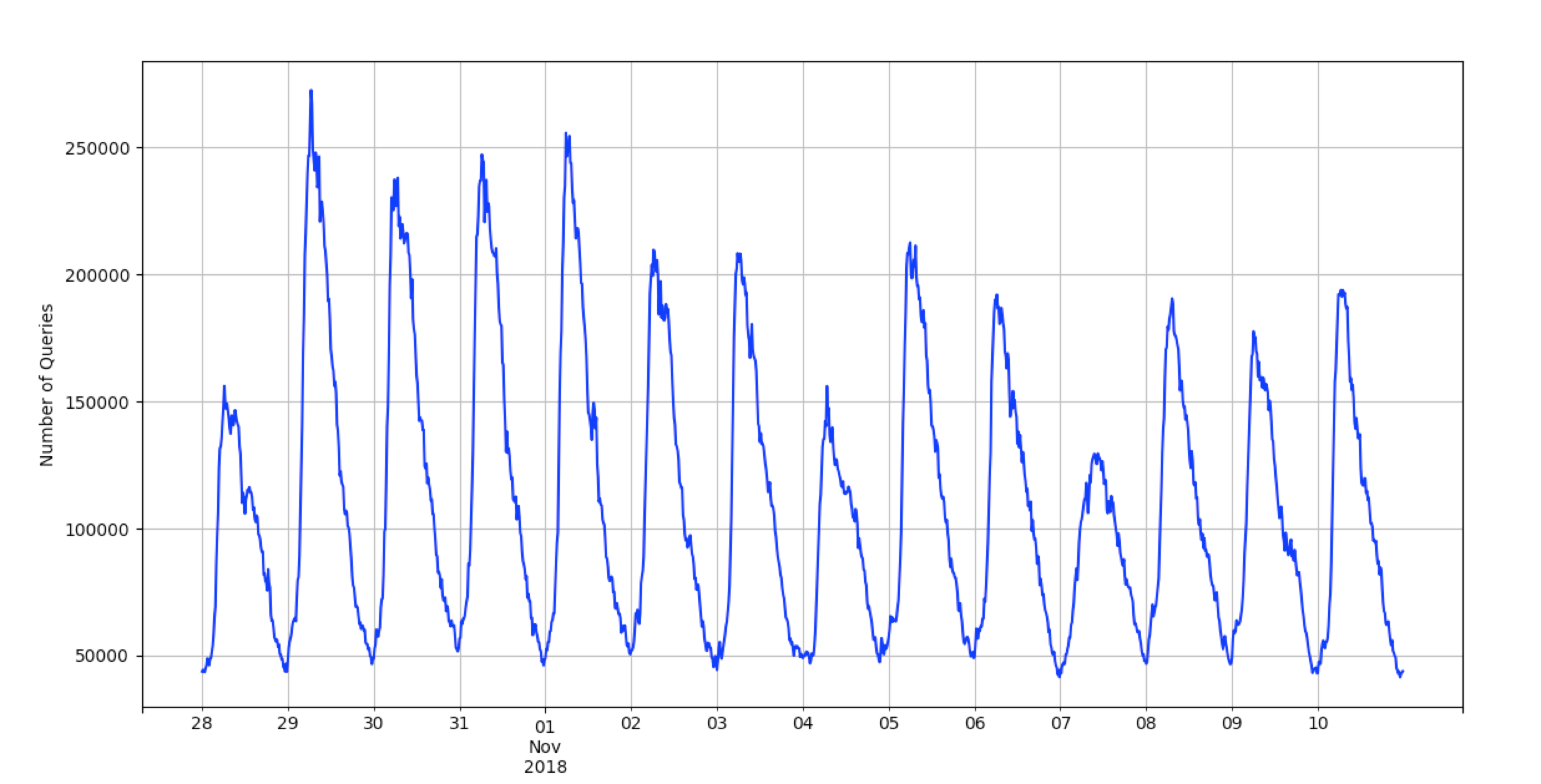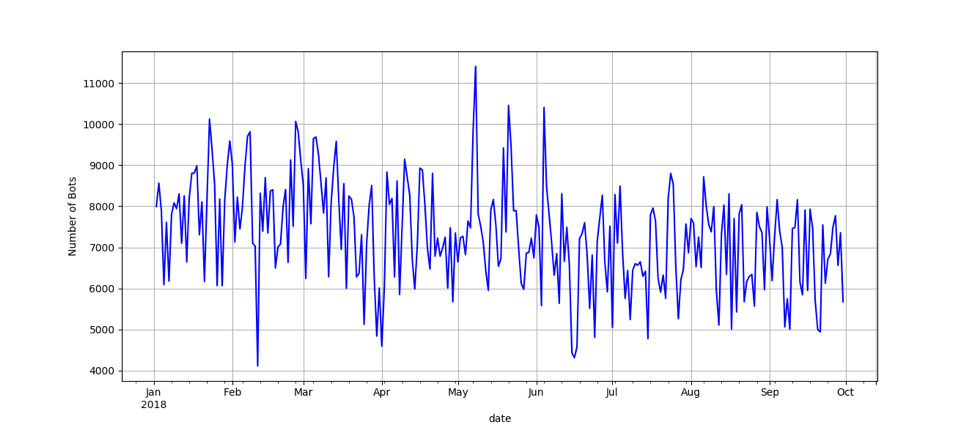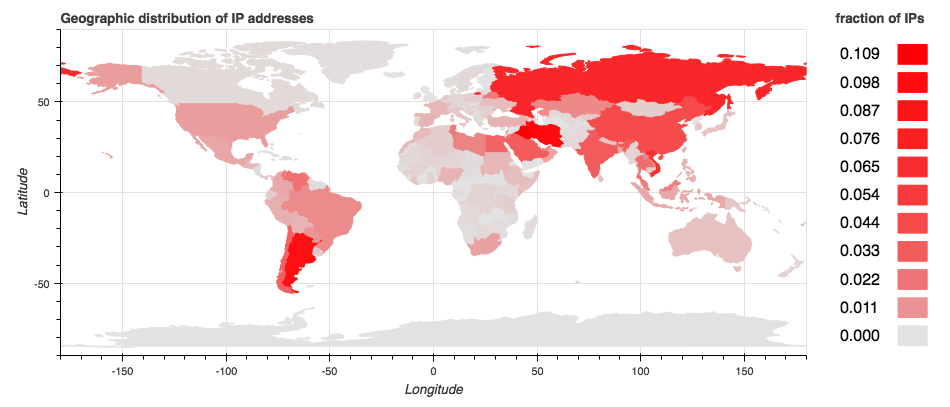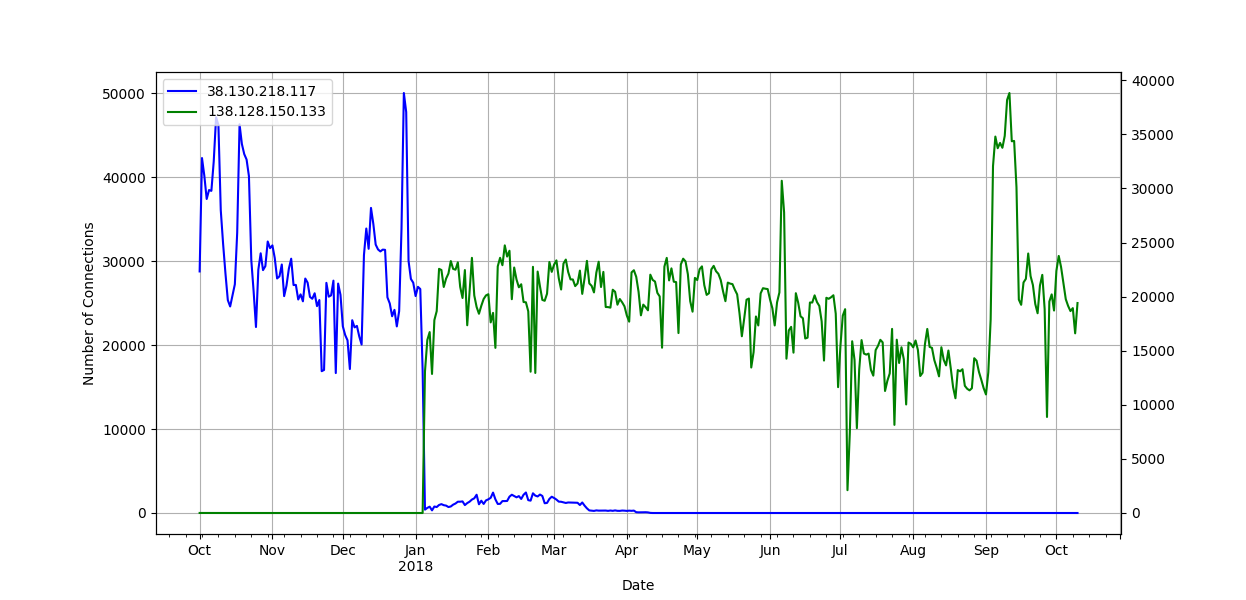Mylobot Continues Global Infections

CenturyLink Threat Research Labs has been tracking the Mylobot botnet, a sophisticated malware family that is categorized as a downloader. What makes Mylobot dangerous is its ability to download and execute any type of payload after it infects a host. This means at any time it could download any other type of malware the attacker desires. A detailed walkthrough and reverse engineering analysis of Mylobot was first reported in June by Deep Instinct. During the time we have been monitoring Mylobot we have observed it downloading the Khalesi malware as a second stage to infected hosts. Kaspersky Lab reports that the information-stealing Khalesi malware is one of the top downloaded malware families in 2018.
We were first alerted to the botnet’s behavior by IPs interacting with our honeypot network. Our team is constantly monitoring attack patterns and looking for common behaviors in these attacks. In this case, we observed a common behavior to DNS lookups coming from a distinct group of these IPs. Each of the hosts performed DNS lookups for domains that we had flagged as likely to be algorithmically generated.
The common behavior was detected by combining the IPs extracted from our honeypot logs with DNS resolution data, and applying unsupervised clustering techniques to isolate large clusters of similarly-behaving devices. The resulting behavior appeared to be callbacks to Domain Generation Algorithm (DGA) generated domains. Our DGA domains list is generated by monitoring lookups to estimate the probability that a domain was generated using a variety of techniques. These techniques could include randomly choosing letters or numbers, or randomly choosing words from a dictionary to make up a domain. The domains being queried by this particular cluster of IPs appeared to be seven randomly-chosen letters with the TLDs .ru, .net and .com. The subdomains ranged from m0 to m42.
Our investigation in to these domains found that they are hardcoded into samples of the Mylobot malware. Mylobot contains sophisticated anti-VM and anti-sandboxing techniques. For example, it sits idle for 14 days before attempting to contact the C2.1 This delaying technique is used to wait out the sandbox environment to avoid detection. When it attempts to contact the C2, the malware uses a set of 1,404 hard-coded domain name and port pairs.
For each domain-port pair, the malware first attempts to resolve 43 subdomains, which are the same as those we saw in passive DNS (m0 through m42). If one of the FQDNs resolves to an IP, the malware tries to connect to the IP on the port that was hard-coded with that domain. With 1,404 domains and 43 subdomains, this results in 60,372 DNS queries from each bot.
The large volume of queries from an individual host can be used as an indication of an infection by this malware. The internet-wide impact of this behavior can be seen when looking at a two-week period. As each region of infected hosts is powered on to begin the day, a large volume of queries occurs, slowly dropping off as each host finds the C2. Below is a graph showing the total number of queries to these domains we see in our DNS traffic over this period.
Through our analysis it was important to understand if the botnet had shown any noticeable variation in size. We found, that while day-to-day sizes may vary due to normal botnet maintenance and data sampling, the botnet’s total size has remained relatively consistent throughout the year. The below graph displays the number of IPs we see in passive DNS traffic querying the domains in question for the current year.
At CenturyLink Threat Research Labs, we leverage our global visibility to identify botnet infrastructure. Analyzing DNS response data allowed us to generate a list of potential C2s from the FQDNs that resolved to IP addresses. Searching our sampled Netflow for traffic from these IPs, we can identify the active C2s and their ports. Below are the active C2s from November and the number of IPs the C2 sent responses to on the C2 port.
| C2 IP | Port | FQDN | Number of IPs |
| 74.222.19.103 | 7432 | m20.fywkuzp.ru | 2,675 |
| 74.222.19.63 | 7432 | m19.fywkuzp.ru | 2,511 |
| 217.23.13.62 | 7432 | m7.fywkuzp.ru | 2,420 |
| 89.39.107.19 | 7432 | m12.fywkuzp.ru | 2,289 |
| 70.36.107.38 | 7432 | m21.fywkuzp.ru | 2,259 |
| 89.39.105.82 | 7432 | m8.fywkuzp.ru | 2,133 |
| 89.38.98.48 | 7432 | m10.fywkuzp.ru | 2,128 |
| 109.236.85.147 | 7432 | m25.fywkuzp.ru | 2,108 |
| 217.23.6.62 | 7432 | m11.fywkuzp.ru | 2,082 |
| 89.38.98.165 | 7432 | m6.fywkuzp.ru | 1,632 |
| 109.236.85.21 | 7432 | m4.fywkuzp.ru | 1,532 |
| 217.23.3.15 | 7432 | m13.fywkuzp.ru | 1,119 |
| 109.236.85.150 | 7432 | m1.fywkuzp.ru | 986 |
| 109.236.85.154 | 7432 | m5.fywkuzp.ru | 971 |
| 46.166.173.180 | 7432 | m24.fywkuzp.ru | 943 |
| 109.236.85.153 | 7432 | m3.fywkuzp.ru | 917 |
| 109.236.85.135 | 7432 | m2.fywkuzp.ru | 840 |
| 109.236.87.49 | 7432 | m9.fywkuzp.ru | 683 |
| 70.36.107.39 | 7432 | m22.fywkuzp.ru | 666 |
| 75.126.102.251 | 9529 | m9.qjwhpfe.net | 344 |
| 109.236.85.93 | 7432 | m26.fywkuzp.ru | 184 |
| 70.36.107.154 | 7432 | m0.fywkuzp.ru | 135 |
In total, there were 9,874 unique IPs that received responses from the C2s on the C2 port for this particular day. Comparing this with other time intervals, we have observed the total number of unique IPs reach as high as 17,979.
There was speculation in the Deep Instinct analysis that a GeoIP filter was being used by the C2s, since researchers were unable to get a response from C2s in certain geographic areas. We were able to get a response from one of the C2s, 70.36.107.154, from an IP located in a different geographic region. Therefore, it is unclear to us if there is any GeoIP filtering taking place. Below is a heatmap showing the concentration of IPs that communicated with the C2s on the C2 port.
Below are the top 10 countries we observed communicating with the C2 on the C2 port on November 10.
| Country | Number of IPs |
| Iraq | 3,014 |
| Iran | 2,788 |
| Argentina | 2,602 |
| Russia | 1,919 |
| Vietnam | 1,786 |
| China | 1,202 |
| India | 926 |
| Saudi Arabia | 914 |
| Chile | 844 |
| Egypt | 798 |
When the malware receives a response from the C2, it XORs it with the byte 0xDE. The resulting string contains up to two URLs. Each URL contains an IP and a file ending in .gif. Below is the decoded response we received from the C2.
'\xde\xde\xde\xde\xd6http://138.128.150.133/winme.gif\x00\xde\xde\xde\xde\xd9http://138.128.150.133/winext.gif\x00\xde\xde\xde\xde\xd8'
The malware connects to this downloader IP and executes the downloaded file. The two files we saw in the C2 response were PE32 executables. These downloaded files appear to be modified quite frequently. While the sizes are always the same, we observed that the file hashes change approximately every 30 minutes. We have included the below hashes as examples for further industry analysis.
winme.gif (267776 bytes) 4ca8ef5d00bde49659ca97faf2a2a47445e6a3e82c151f18f0923392826d5af0
winext.gif (180224 bytes) b7245ed896cd4199b410a326e1295aafb3e23c3311d301b1cdaf964cf7c008d9
Through collaboration with Kurt Baumgartner at Kaspersky Lab, we believe we can positively identify the second stage payload as the information-stealing Khalesi malware. Using a graph analysis technique to find IPs of interest that communicated with a large number of bots, we were able to identify two downloaders. One of the downloaders, 138.128.150.133, is currently very active and was also the one contained in the response we decoded from the C2. VirusTotal confirms this IP as a malware distribution host. All the URLs associated to this IP have similar names to the ones above ending in .gif and are flagged as Khalesi or Zusy malware. This behavior appears as far back as April.
The other downloader, 38.130.218.117, was active until the beginning of the year. The plot below shows the number of connections to both, with a clear transition of infrastructure occurring at the beginning of the year.
By combining different data sources, such as DNS and Netflow, and using unsupervised clustering and graph analysis techniques, CenturyLink Threat Research Labs has been able to track the bots, C2s and downloaders for the Mylobot botnet. This analysis, performed without access to specific malware samples shows the power that network forensics can play in tracking malicious infrastructure. CenturyLink has blocked this infrastructure on our network to mitigate risk to our customers and notified the owners of any components operating within their environments to clean up and protect the global internet.
For a full list of IOCs such as the C2 domains and IPs, the downloader IP and the file hashes, please visit our GitHub page.![]()










